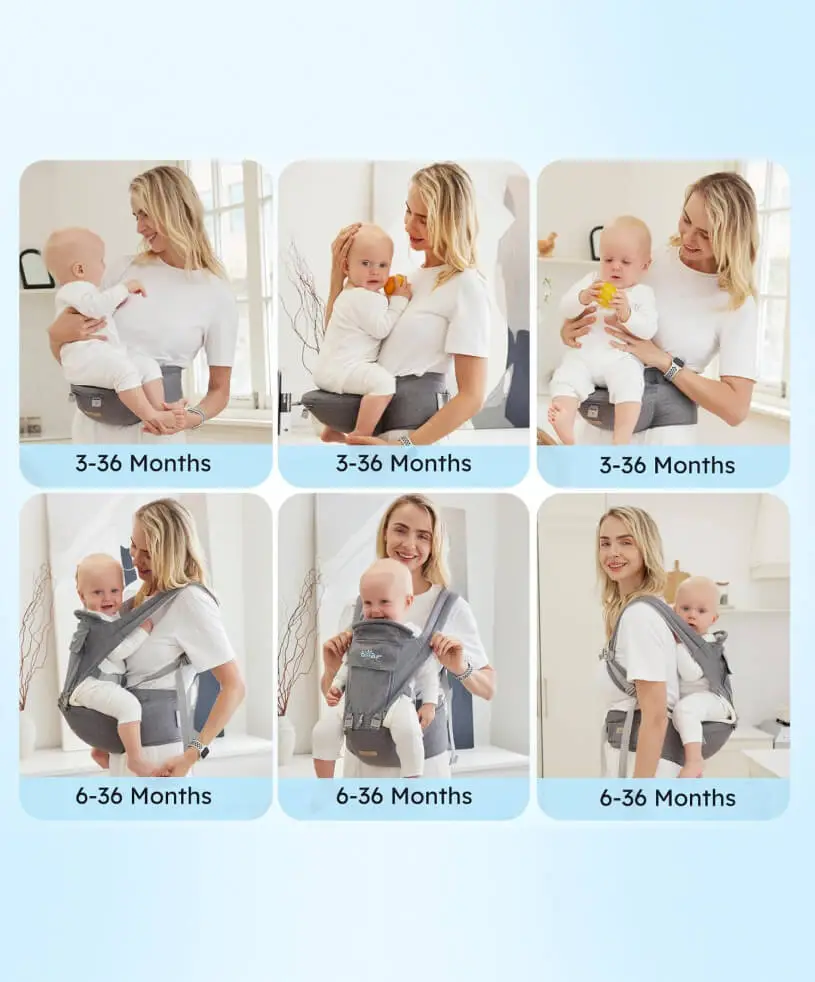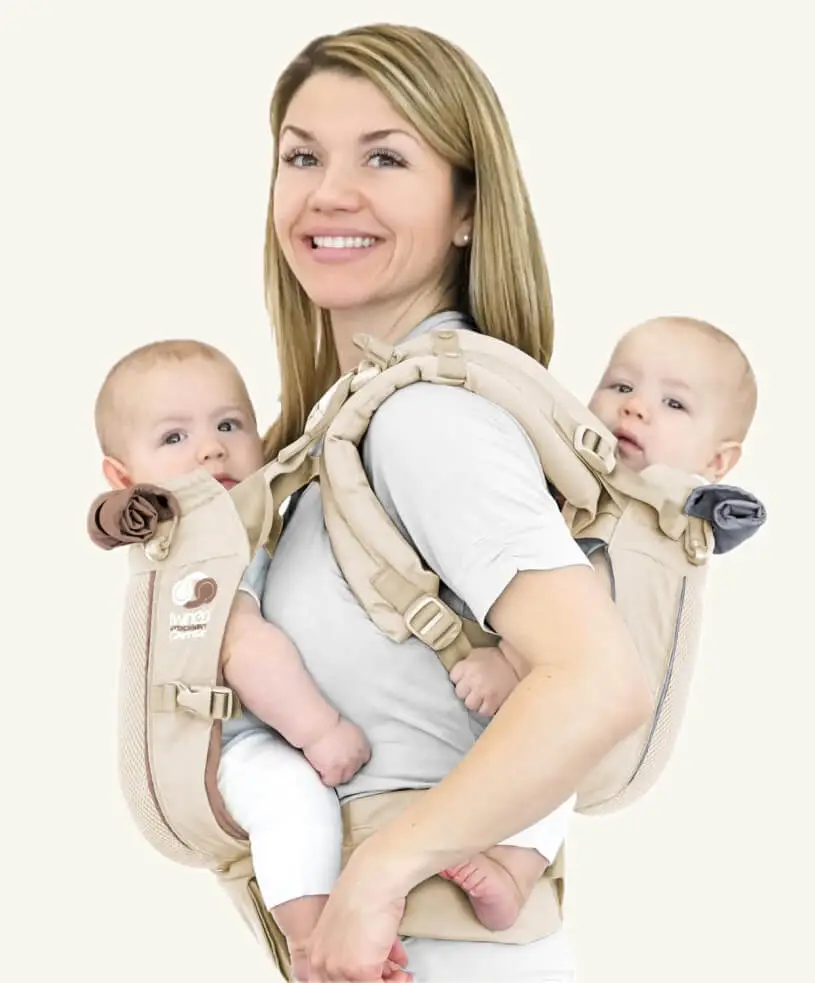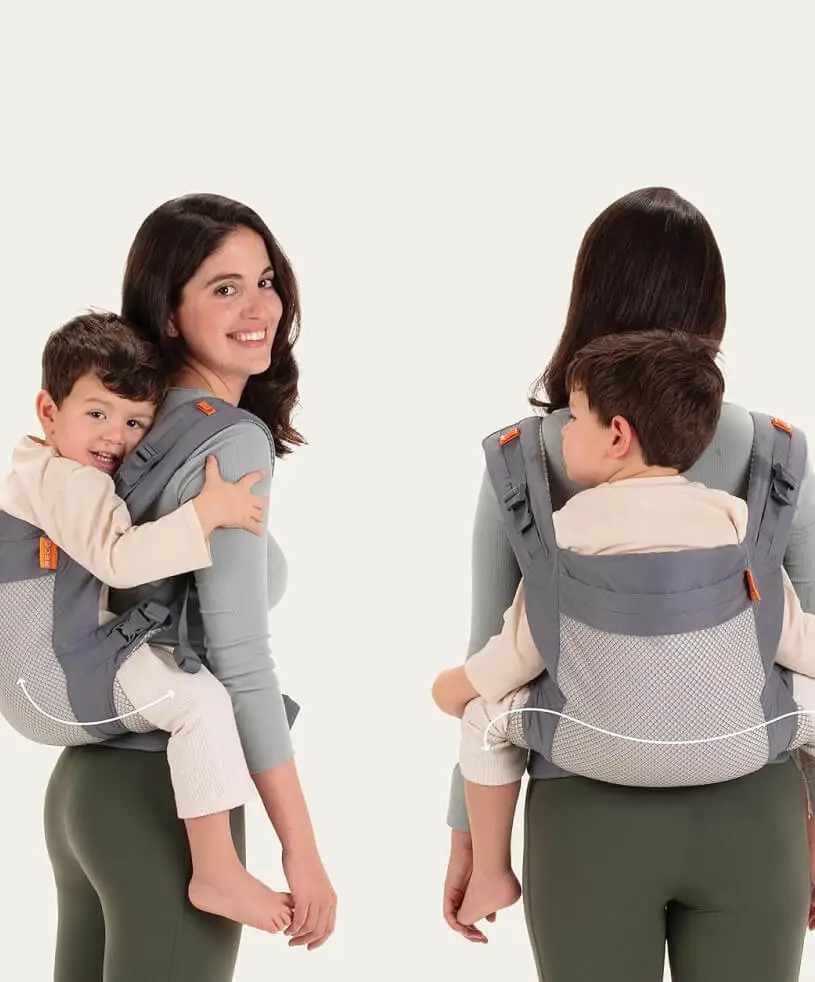The Best Baby Carriers of 2025
Last Updated: 30th November 2025
I’m passionate about keeping parents comfortable and babies close. I spent months testing carriers, and I'm reader-supported through purchases on Amazon.
Those first weeks are full of cuddles, catnaps, and figuring things out together. The right baby carrier helps you keep your little one close while you go about daily life - hands free, heart full. Over the years, I’ve helped hundreds of new parents find a comfortable, safe fit that works for their bodies and their routines.
This guide brings together the carriers that consistently feel good, wear well, and make everyday moments easier.
Top 3 out of 7 Baby Carriers
I know many new parents are short on time, so if you’re simply looking for the best baby carriers, here are our top 3 picks of the year.
These selections are based on real hands-on testing, real-world fit checks with families, and long-term comfort for both baby and parent.
Whether you’re heading out for a walk or settling in for skin-to-skin cuddles, these are the carriers that consistently perform - safe, supportive, and thoughtfully designed for daily life.
Best Overall - WildBird Aerial Carrier
Why it keeps rising to the top
✅ Cozy, supportive seat that encourages a healthy “M” leg position
✅ Wide, padded straps that take pressure off your shoulders
✅ Easy adjustments when swapping between caregivers
✅ Front, hip, and back carry options as your baby grows
✅ Breathable fabric; machine washable
💡 Good to know: It’s a premium buy and usually online-only.
🐥 Midwife’s note: If you want one carrier to cover most situations from school runs to weekend walks, start here.
Best on a budget - Koala Babycare Wrap
Why families love it:
✅ Easy to wear with ring closure for a secure, custom fit
✅ Made from breathable cotton, soft yet firm enough to support your back
✅ One-size-fits-all - suitable for mums, dads, and even grandparents
✅ Cradle and upright carry positions support bonding and feeding
✅ Lightweight, machine-washable fabric (stays clean and fresh with little effort)
Best for Newborns & Travel - Baby Tula Lite Compact Carrier
Why it stands out:
✅ Packs into its own roomy hip pouch - perfect for snacks, dummies, or simply storing the carrier itself.
✅ Lightweight design (under 1 lb) that still supports healthy hip alignment.
✅ Quick-adjust straps make it easy to swap between parents or caregivers.
✅ Breathable ripstop nylon and mesh keep both you and baby cool in warm weather.
✅ Machine washable - a lifesaver after airports or long travel days.



Find Your Best Fit: Carrier Types & When to Choose Them
Short, practical guidance so you can pick with confidence
Wraps (stretchy/elastic): Newborn comfort kings. They’re soft, snug, and wonderful for skin-to-skin bonding and naps. Choose this if: you want cozy cuddles and don’t mind a bit of tying practice.
Soft-structured carriers (SSCs): Buckles + padded straps = easy, supportive, shareable. Great from infancy (with the right seat) through toddlerhood. Choose this if: you want comfort, structure, and multiple positions (front/hip/back).
Hip-seat carriers: Built-in shelf to rest baby’s weight on your hips—less strain during up-down toddler days. Choose this if: your back gets tired or you do lots of short carries at home.
Ring slings: Fast on/off, especially for soothing and quick errands. Lovely for contact naps and nursing on the go. Choose this if: you prefer a one-shoulder carry and quick adjustments.
Convertible 4-way carriers: Add forward-facing when baby has strong head/trunk control and cues they want to look out. Choose this if: you want options as baby becomes curious.
Twin carriers: Front + back or split into two singles. Choose this if: you’re juggling two sweeties and want a safe, practical way to keep moving.
Safety & comfort quick-check (use every time):
✅ Baby’s airways visible, chin off chest, face kissable
✅ Seat supports from knee to knee (no dangling legs for little babies)
✅ Snug enough that baby doesn’t slump; your back feels supported
✅ Listen to your body, adjust straps, try a new position, or take a break
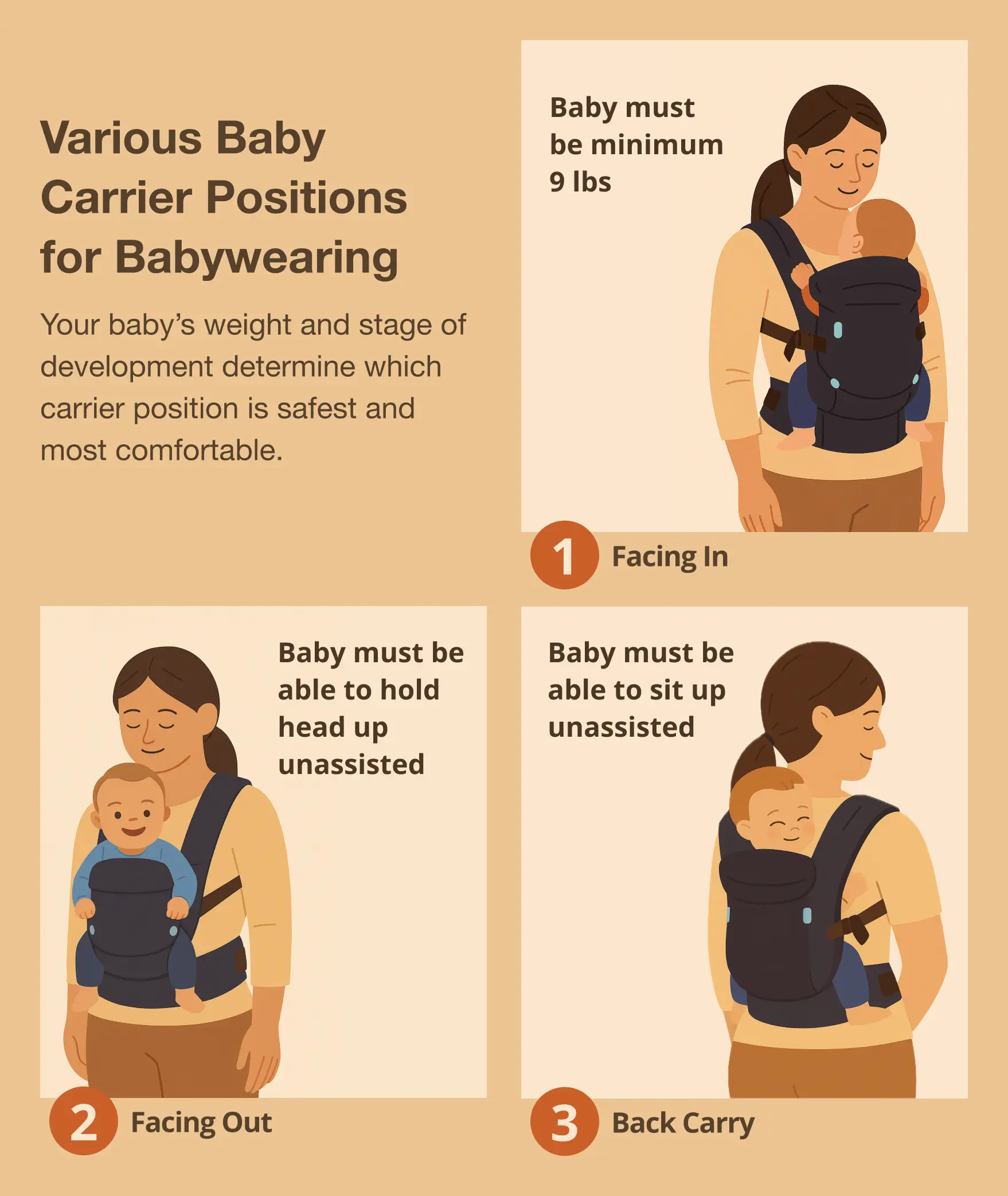
Compare the Best Baby Carriers of 2025
Over the years, I’ve guided countless new parents through choosing their first carrier, and one thing I’ve learned is this: what works perfectly for one family may not suit another. That’s why I’ve gathered these top carriers into a simple comparison table. Here, you’ll see weight ranges, carry positions, and standout strengths side by side - so you can quickly spot which carrier might fit your baby, your lifestyle, and your budget best.
This overview gives you the essentials at a glance, but each carrier has its own unique feel and story. In the reviews that follow, I’ll share deeper insights drawn from both my professional experience supporting families and my personal life as a mom. By combining comfort, practicality, and safety, these carriers have earned their place on this year’s list and I’ll help you decide which one deserves a place in your home.
Best Baby Carriers 2025 - Full Reviews
Now that you’ve seen the comparison table, let’s take a closer look at each carrier in detail. Over my years as a midwife and as a mom, I’ve tried and seen families try every type of wrap, sling, and structured carrier imaginable. The truth is, no two babies and no two parents are the same. What makes one family’s “perfect carrier” might feel awkward or uncomfortable for another.
That’s why these reviews go beyond just listing features. I’ll walk you through how each carrier fits in real life: how it feels on your shoulders after an hour, how easily you can swap it between parents, and how babies actually settle into them. By combining professional insight with personal, hands-on experience, I’ll help you cut through the noise and find a carrier you can feel confident using every day.
1. Best Overall: WildBird Aerial Carrier
The WildBird Aerial Carrier is one I recommend time and again to new families. Made from 100% natural European linen, it’s soft, breathable, and built to last. Linen naturally molds with use, so the more you wear it, the cozier it feels. The design keeps baby’s hips in the healthy “M” position while giving your back and shoulders proper support. With a weight range of 7–45 lbs, this carrier truly grows with your child - from those first newborn naps through busy toddler adventures.
As both a midwife and a mom, I’ve seen how important it is for carriers to be comfortable for parents as well. The Aerial shines here: wide padded straps and a supportive waist belt spread weight evenly, making it a favorite for plus-size parents, taller dads, and caregivers with broader builds. It also offers multiple carry positions - newborn inward-facing, hip carry, and back carry - so you can adapt as your baby grows and their curiosity changes.
Full WildBird Aerial carrier review
WildBird Aerial Carrier
Standout comforts
✅ 100% European linen - breathable, durable, softens with every wash
✅ Wide, padded straps and lumbar support for longer wear
✅ Two size options: Small (XS–XL) and Large (L–4XL) for inclusive sizing
✅ Multiple carry positions: newborn inward-facing, hip, and back carry
✅ Machine washable and folds down compactly
Keep in mind
💡 No built-in hood for sun/rain (a muslin cloth or baby hat works well)
💡 Higher price point than wraps, but replaces multiple carriers over time
💡 Only available online - size carefully before ordering
⭐️ Best for: Parents who want one all-in-one carrier that’s cozy, breathable, and supportive from newborn through toddler years. A top choice for plus-size moms, taller dads, and families wanting a durable, long-term option.
2. Best on a Budget: Koala Babycare Baby Carrier Wrap
The Koala Babycare Wrap has become a go-to for parents looking for an affordable, fuss-free carrier that still provides ergonomic comfort. Often considered the best budget baby carrier wrap for newborns, it’s made from soft cotton with a touch of stretch, so it feels like slipping on a T-shirt, fast to put on and gentle on delicate skin. Its ergonomic back panel and adjustable ring closure help spread weight evenly across your shoulders and lumbar area, giving you far more comfort than traditional stretchy wraps that often sag after a few wears.
With a weight limit of 7 to 22 lbs, it’s best suited for the fourth trimester and early baby months. The wrap supports two key carrying positions:
Cradle hold for newborn bonding and discreet breastfeeding.
Upright position for soothing reflux, colic, or simply keeping baby close during naps.
As a midwife, I’ve recommended this wrap to many new parents who need something quick, affordable, and supportive for those first few months. It’s especially useful for contact naps and cluster-feeding days when putting baby down just isn’t an option. Because of its breathable cotton, it’s also a parent favourite for warmer homes and summer months, where bulkier carriers can feel overwhelming.
Koala Babycare Baby Carrier Wrap
Standout comforts
✅ Easy to wear with ring closure for a secure, custom fit
✅ Made from breathable cotton, soft yet firm enough to support your back
✅ One-size-fits-all, suitable for mums, dads, and even grandparents
✅ Carrying positions: cradle and upright, both supportive for newborn comfort
✅ Lightweight, machine-washable fabric (stays clean and fresh with little effort)
Keep in mind
💡 Limited weight support - as babies approach 20+ lbs, some parents prefer a more structured carrier
💡 No built-in sun/rain hood (many pair it with a muslin cloth or baby hat)
💡 Slight learning curve to find the most comfortable fit on shorter torsos
⭐️ Best for: Parents on a budget who want a simple, breathable newborn wrap that encourages closeness and soothes fussy babies, while offering lumbar comfort for longer wearing sessions.
3. Best for Newborns & Travel: Baby Tula Lite Compact Baby Carrier
The Baby Tula Lite Compact, also known by some as the Tula Explore, has become my go-to recommendation. I suggest it especially for families who want a carrier that can truly keep up with travel, errands, and day-to-day life.
At under 1 lb, it folds into its own waistband pouch, making it one of the easiest carriers to slip into your nappy bag or carry-on. For parents who don’t want to lug around a bulky, full-size carrier, this one makes babywearing practical, without compromising hip safety or comfort.
With a weight range of 12 to 30 lbs, it supports your baby from the early months right up until toddlerhood. The Lite Compact keeps little hips in the ergonomic “M” seat, while its breathable ripstop nylon and soft mesh padding make it a favourite for warmer homes or summer travel.
It offers two carry positions:
Front-inward carry for bonding, naps, or grocery runs.
Back carry for when your little one gets bigger and wants to see more of the world.
Baby Tula Lite Compact Baby Carrier
Standout comforts
✅ Packs into its own roomy hip pouch, perfect for snacks, dummies, or simply storing the carrier itself.
✅ Lightweight design (under 1 lb) that still supports healthy hip alignment.
✅ Quick-adjust straps make it easy to swap between parents or caregivers.
✅ Breathable ripstop nylon and mesh keep both you and baby cool in warm weather.
✅ Machine washable - a lifesaver after airports or long travel days.
Keep in mind
💡 Only supports front-inward and back carry - no outward-facing option.
💡 Less cushioned than a structured carrier, so not ideal for hours-long hikes.
💡 Waistband pouch can feel a bit snug if you overpack it.
⭐️ Best for: Parents who travel often and want an ultra-light, packable option that slips into a bag without adding bulk. It’s also ideal for families looking for a reliable backup carrier that can live in the car, pram, or suitcase, and for minimalists who value gear that’s lightweight but still supportive enough for everyday use.
4. Best for Support (Back, Shoulders, Abdomen): Ergobaby Omni 360
When parents ask me for the best baby carrier for back support, the Ergobaby Omni 360 (Omni Breeze) is my first suggestion. Its wide, structured waistband and padded lumbar panel hug your lower back, while the crossable padded shoulder straps spread your baby’s weight evenly across your shoulders. The result? Real comfort that makes daily walks, errands, or even hours of babywearing much easier on your body.
With a weight range of 7 to 45 lbs, it’s designed to support your child from newborn snuggles through to busy toddlerhood. Unlike more compact carriers, the Omni 360 offers four carry positions:
Front-inward for newborn bonding.
Front-outward once your baby is ready to face the world.
Hip carry for curious little ones.
Back carry for toddlers and longer outings.
As a midwife, I often recommend this carrier to parents recovering from C-sections or those prone to back pain, because its lumbar panel and structured fit take the strain off sensitive areas while still keeping baby secure.
Full Ergobaby Omni 360 Review
Ergobaby Omni 360
Standout comforts
✅ Excellent lumbar support and padded straps, a lifesaver for parents with back or shoulder pain.
✅ All carry positions supported, offering flexibility as your baby grows.
✅ SoftFlex mesh maximizes airflow, keeping both you and baby cool even in summer .
✅ Built-in UPF 50+ hood provides sun protection and privacy while breastfeeding.
✅ Machine washable and durable - families report it holds up through years of use.
Keep in mind
💡 Heavier than minimalist wraps or compact carriers, so it’s not the most “grab-and-go” option.
💡 Premium price point, but it often replaces the need for multiple carriers.
💡 Can feel bulky for very short errands, but shines for long wear times.
⭐️ Best for: Parents who need maximum support for their back, shoulders, and abdomen, while still having the flexibility of multiple carry positions. It’s especially useful for families who enjoy daily walks, travel, or longer wearing sessions, and want one carrier that adapts from newborn to toddler without compromise.
5. Best with a Hip Seat: Acumas Baby 6-in-1 Carrier with Hip Seat
When parents ask me for the best baby carrier with hip seat, the Acumas 6-in-1 is the model I point them toward. Its built-in hip seat acts like a little perch, shifting your child’s weight onto your hips instead of your shoulders alone. This makes it a lifesaver on those “up, down, up again” days with a busy baby or toddler.
Made from breathable cotton with wide padded straps and a supportive lumbar belt, this carrier is designed to ease pressure on your back while still keeping your baby secure. The ergonomic hip seat also protects your child’s spine and hips, supporting healthy posture as they grow.
With a weight capacity of up to 40 lbs (approx. 36 months), the Acumas adapts through the early years and offers six carry positions:
Front inward for newborn closeness.
Front outward when your baby wants to explore.
Back carry for toddlers and longer outings.
Hip seat inward for quick ups and downs.
Hip seat outward for quick ups and downs.
Hip seat side-lying, a discreet option for breastfeeding on the go.
As a midwife, I often recommend hip seat carriers like this to parents with active toddlers or anyone managing back strain. Having that little seat does wonders for posture and makes repeated pick-ups far more manageable.
Acumas Baby 6-in-1 Carrier with Hip Seat
Standout comforts
✅ Hip seat reduces strain during quick pick-ups
✅ Multiple positions for everyday use
✅ Breathable fabric for warm climates or cozy homes
Keep in mind
💡 Bulkier than wraps or compact soft-structured carriers.
💡 Fewer colour and style options compared to premium brands.
💡 Hip seat can feel oversized for very petite parents.
⭐️ Best for: Parents of toddlers or bigger babies who need extra support during daily short carries, whether at home, on errands, or while managing multiple children. If you want a hip seat carrier that balances back support with flexibility, the Acumas is a budget-friendly and reliable option.
6. Best for Twins: TwinGo Original
For twin parents, everything comes in twos, double the car seats, double the feeds, and yes, double the babywearing needs. The TwinGo Original makes that load a little easier by letting you carry both babies comfortably at once.
With a weight range of 10 to 45 lbs per child, the TwinGo supports your little ones from newborn days (with the infant insert, sold separately) through toddlerhood. It’s one of the only carriers on the market that allows true tandem carrying (front + back) or can split into two single carriers so each caregiver can take a baby. That flexibility makes it a standout for families of multiples.
I often recommend the TwinGo to parents of twins who want to stay mobile without juggling multiple prams. Being able to keep both babies close, one on your chest and one on your back, not only frees up your hands but also helps soothe fussy little ones through skin-to-skin closeness.
TwinGo Original
Standout comforts
✅ Converts from tandem to two singles - parents can share the load or go solo.
✅ Supports 10–45 lbs per child (with infant insert for babies 7–10 lbs).
✅ Breathable mesh and UPF 50+ hoods keep babies cool and sun-protected.
✅ Adjustable straps and waistband fit a wide range of adult body types (XS–XXL).
✅ Large side pockets for essentials like pacifiers, wipes, or snacks.
Keep in mind
💡 Heavier than single carriers, especially in tandem mode.
💡 Takes some practice to master fitting securely; best to rehearse at home first.
💡 More expensive than standard carriers, though it replaces the need for two.
⭐️ Best for: This is the best baby carrier for twins and an essential investment for families with multiples. Whether you need the freedom of tandem carrying for errands or want to split into two singles for flexibility, the TwinGo makes babywearing with twins both practical and comfortable.
7. Best Backpack Baby Carrier: Beco Baby Carrier
When parents ask me for the best backpack baby carrier, the Beco is often my go-to. Designed for toddlers and preschoolers, it supports a generous 20–60 lbs weight range, making it ideal for families who still want the option to carry older little ones on hikes, nature walks, or city errands.
The wide padded straps and supportive waist belt help distribute weight evenly, while its breathable cotton and mesh panels keep both parent and child cool. Unlike bulky framed hiking carriers, the Beco folds down neatly, so you can store it in the car or cupboard without it taking over.
It also comes with a detachable hood to shield from the sun or provide privacy for naps and breastfeeding. Parents can choose between H- or X-style strap configurations, tailoring the fit for comfort. With both front and back carry positions, it’s a straightforward but versatile option.
I recommend the Beco for parents who love being outdoors and want to include their toddlers on longer walks or hikes. The balance between back support, breathability, and practicality makes it a reliable choice once your little one has outgrown the newborn phase but still needs carrying on tired legs.
Beco Baby Carrier
Standout comforts
✅ Extra-wide weight range: supports 20–60 lbs (18–48 months)
✅ Breathable cotton and mesh for ventilation
✅ Adjustable straps with H/X options for parent comfort
✅ Detachable hood for sun protection or discreet feeding
✅ Handy storage pockets for essentials
Keep in mind
💡 Not as padded as premium framed hiking carriers
💡 Less storage than specialized trekking packs
💡 Bulkier than ultra-light wraps or slings
⭐️ Best for: This is the best backpack baby carrier for parents who value simplicity and comfort while staying active outdoors. Whether strolling around town or trekking through trails, the Beco offers a supportive, no-fuss way to keep your toddler close.
Under-$100 Carriers: Are They Worth It?
Yes, especially for the early months. For newborns, comfort, safety, and proper positioning matter far more than extra features or designer branding. Many budget-friendly wraps and simple soft-structured carriers (SSCs) do a wonderful job of keeping your baby close, supported, and secure, as long as they’re worn correctly.From my experience, I’ve seen countless parents thrive with affordable carriers.
The key is fit and fabric:
- Choose breathable, soft materials (like cotton or bamboo blends) that stretch slightly but still support your baby’s weight evenly.
- Look for wide shoulder straps or wraps that spread fabric broadly across your back, this prevents sore spots after long wearing sessions.
- Always check that your baby’s seat forms a gentle “M” shape, with knees slightly higher than their bottom and hips supported from knee to knee.
You don’t need every add-on or adjustment dial to babywear safely and comfortably. A well-fitting under-$100 carrier can be every bit as supportive as a premium model, particularly during those first six months when babies are light and crave closeness.
If your shoulders, lower back, and baby’s hips all feel supported, you’ve found a carrier that works for you, no matter what the price tag says.
How to Choose the Right Baby Carrier: A Quick Cheat-Sheet
Choosing the right baby carrier can feel like a maze, especially when you’re sleep-deprived and juggling a newborn. Over the years, I’ve helped hundreds of parents find their perfect fit, and it almost always comes down to a few simple questions. Here’s your quick guide to choosing the right baby carrier for your body, your baby, and your lifestyle.
Your Baby’s Stage
Newborns (0–3 months): Soft wraps and inward-facing structured carriers (SSCs) are best. Look for gentle head support and fabrics that keep baby snug without overheating.
Curious Sitters (4–8 months): As your baby gains head control, you can introduce short forward-facing sessions so they can explore safely while staying close.
Toddlers (9+ months): Structured carriers and hip-seat styles offer more support for growing babies and make quick pick-ups easier on your back.
Your Body Comfort
Every parent’s body is different. Test how the waistband sits on your hips and lower back, it should feel snug and stable, not digging in. Choose carriers with wide, padded shoulder straps to help spread weight evenly and prevent shoulder or neck strain.
Your Lifestyle
Think about where you’ll wear your carrier most:
- City walks or errands? Go for lightweight, breathable carriers with easy buckles.
- At home for naps or chores? A wrap or hybrid carrier offers comfort and flexibility.
- Hiking or travel? Pick a structured or backpack-style carrier with strong lumbar support and storage pockets.
Adjustability
If you’ll be sharing the carrier with a partner, easy strap adjustments make all the difference. Look for quick-release buckles, sliding straps, and adjustable waistbands so both caregivers can find a comfortable fit within seconds.
Care & Maintenance
Life with a baby is messy, spit-ups, spills, and snack crumbs are all part of it. Machine washed fabrics make life easier, especially during those early months when laundry feels endless.
Midwife’s Tip: Life with a baby is messy, spit-ups, spills, and snack crumbs are all part of it. Machine washed fabrics make life easier, especially during those early months when laundry feels endless.
Safety & Fit: A Friendly Reminder
As a midwife, I can’t emphasize enough how important correct fit and safety are when babywearing. Even the most comfortable or expensive carrier only works well if it’s worn properly. These quick checks can help you ensure your baby is secure, supported, and breathing easily every time you wear them.
The Baby Carrier Safety Basics
✅ Airway visible and clear: Always keep your baby’s face uncovered. You should be able to see their nose and mouth at a glance, no fabric or padding should block their airways.
✅ Chin up, not tucked: Make sure your baby’s chin isn’t pressed against their chest. There should be at least a finger’s width of space under their chin to keep airways open.
✅ Close enough to kiss: Your baby should sit high and snug on your chest, close enough that you can comfortably kiss the top of their head without straining your neck.
✅ Supported seat, not dangling legs: Your baby’s hips should form the natural “M” shape, with knees slightly higher than their bottom and the carrier supporting from knee to knee. This keeps hips healthy and reduces strain on developing joints.
✅ Snug but not tight: The carrier should feel like a firm hug, secure enough that baby doesn’t slump, but not so tight that it restricts your breathing or theirs.
✅ Comfort for both of you: If you feel strain in your back, shoulders, or hips, readjust. Good carriers should spread baby’s weight evenly, helping you stand tall without discomfort.
✅ Regular check-ins: Babies change quickly. Check your fit often, especially as they grow, gain head control, or move into new carry positions.
Midwife’s Tip: Whenever I teach parents about babywearing, I remind them of the acronym T.I.C.K.S., which stands for Tight, In view at all times, Close enough to kiss, Keep chin off chest, Supported back. It’s a simple way to remember
The T.I.C.K.S. Rule

Common Baby Carrier Mistakes to Avoid
Even the best carriers can feel uncomfortable (or even unsafe) if they’re not used correctly. Over the years, I’ve seen the same small mistakes pop up again and again, all easy to fix with a few gentle reminders.
Here are the most common ones to watch for:
1. Wearing Baby Too Low
If your baby sits too low on your torso, their weight can pull on your shoulders and strain your back. The rule of thumb: “close enough to kiss.” You should be able to kiss the top of your baby’s head without leaning forward.
2. Chin-on-Chest Position
This is one of the biggest airway risks. Always make sure there’s a visible gap - at least one finger’s width, under your baby’s chin so they can breathe freely. Newborns, in particular, need constant airway visibility and support.
3. Dangling Legs (No “M” Shape)
Babies should never hang straight down from the crotch. Instead, their knees should be slightly higher than their bottom, forming a natural “M” shape. This position keeps hips healthy and prevents strain on joints, especially in the early months.
4. Ignoring Your Own Comfort
If your shoulders ache or your lower back feels sore, stop and readjust. Carriers should support you as much as your baby. Look for even weight distribution, a snug waistband, and padded straps.
5. Using Forward-Facing Too Soon
Babies need good neck and head control before they can safely face outward. For most, that’s around five to six months. Before then, stick to inward-facing holds for security and support.
6. Skipping Fit Checks Over Time
Babies grow quickly, and what fit perfectly one month might not the next. Regularly check strap tension, hip alignment, and seat width as your baby gets bigger - especially during growth spurts.
Midwife’s Tip: Baby Carriers should feel like a natural extension of your hug - secure, supported, and comfortable for both of you. If something doesn’t feel right, trust your instincts, take a breath, and adjust.
FAQs
As a midwife, I’m often asked about babywearing, from safety and comfort to when babies can face out or how long they can be carried. These are the most common questions I hear during home visits and postnatal check-ins, paired with the same practical, real-world advice I give to new parents every day.
What is the safest baby carrier for newborns?
The safest baby carrier for newborns is one that keeps your baby upright, snug, and supported. Look for fabric wraps or inward-facing soft-structured carriers (SSCs) that allow the “M” leg position and support your baby’s head and neck. The key safety checks are a visible airway, chin off chest, and a firm, secure fit.
When can my baby face outward in a carrier?
Most babies are ready to face outward between 5–6 months, once they have strong head and neck control. Begin with short outward-facing sessions so they can explore safely, and always watch for signs of overstimulation or tiredness.
How long can I wear my baby in a carrier?
You can wear your baby for as long as you’re both comfortable. Many parents do 45–90-minute stretches before taking a break. Always follow your baby’s cues and your own body’s comfort - good carriers distribute weight so your back and shoulders don’t strain.
Are baby carriers safe for hips?
Yes - when worn correctly. Babies’ hips should rest in the ergonomic “M” position, with knees higher than their bottom and the carrier supporting from knee to knee. This promotes healthy hip development and reduces the risk of hip dysplasia.
What’s better: a wrap, a sling, or a structured carrier?
Each has its place.
- Baby Wraps are perfect for newborns and skin-to-skin bonding.
- Slings are fast and convenient for quick pick-ups or contact naps.
- Structured carriers (like the Ergobaby or WildBird) provide long-term support and are ideal for older babies or longer wear times.
Many families start with a wrap, then move into a structured carrier as their baby grows.
Can I breastfeed in a baby carrier?
Yes - many carriers make discreet breastfeeding possible. Adjust your baby to a slightly lower position, loosen the shoulder strap for access, and support their head at all times. Always return to the upright position after feeding to keep the airway clear.
What’s the best baby carrier for back pain?
Yes - many carriers make discreet breastfeeding possible. Adjust your baby to a slightly lower position, loosen the shoulder strap for access, and support their head at all times. Always return to the upright position after feeding to keep the airway clear.
How do I know if my baby carrier fits correctly?
Your baby should be close enough to kiss, snug against your chest with their face visible. The waistband should sit on your hips (not your waist), and shoulder straps should feel secure but not tight. You shouldn’t feel pulling in your neck or lower back.
Are budget baby carriers safe?
Yes - as long as they meet safety standards and you follow proper fit guidelines. Focus on fabric quality, secure stitching, and the M-shape seat position. Many under-$100 fabric wraps and carriers are just as safe and cozy for newborns when used correctly.
Can dads or plus-size parents use baby carriers comfortably?
Absolutely. Many modern carriers, including the WildBird Aerial and Ergobaby Omni 360 - offer inclusive sizing with adjustable waistbands and extended straps. The right fit ensures both parents can share the carrier comfortably and confidently.
Do baby carriers help with colic or reflux?
Yes - keeping your baby upright after feeding can help ease reflux and colic symptoms. The gentle motion and closeness of babywearing often soothe fussy babies and promote better digestion.
How do I clean my baby carrier?
Most carriers are machine-washable. Spot cleaning with a gentle, fragrance-free detergent, cold water, and avoid fabric softeners that can weaken elastic fibres. Always check the manufacturer’s care label before washing.
Can I use a baby carrier right after a C-section?
In most cases, yes - but it depends on your recovery and your doctor’s advice. Many parents find wraps or hip-seat carriers more comfortable post-surgery because they keep pressure off the incision site. Always start slow and listen to your body.
When should I stop using a baby carrier?
Most carriers support babies up to 35–45 lbs, but comfort is the key factor. As your child grows more independent, you may find yourself using the carrier for naps, travel, or family outings rather than daily wear.
What’s the number one rule of babywearing safety?
Always keep your baby visible and kissable. If you can see their face, kiss their head, and feel their breathing - you’re babywearing safely.
Closing Advice
After more than a decade supporting new parents as a midwife - and wearing my own little ones through countless feeds, naps, and walks - I can say with confidence that babywearing is more than convenience. It’s connection. It keeps your hands free, your heart close, and your baby calm and secure through every stage of growth.
Whether you’re in the newborn haze or chasing after a busy toddler, the right baby carrier should feel like an effortless extension of your embrace - comfortable, safe, and made for everyday life.
If you’re just getting started:
- The WildBird Aerial is my top all-rounder for comfort and longevity.
- The Koala Babycare Wrap offers a perfect under-$100 option for those first cuddly months.
- And the Baby Tula Lite Compact is ideal if you’re always on the go and want something light and travel-friendly.
Whatever you choose, remember, there’s no single “best” baby carrier for everyone. The best one is the one that supports you and your baby in this moment, in the life you’re living right now.
So take a deep breath, trust your instincts, and enjoy those hands-free cuddles. You’re doing beautifully and your little one will thank you for every heartbeat they hear while nestled close to you.
Ready to find your perfect match?
Explore the options above and check today’s prices on Amazon to see which carrier fits your life best.
Claire Matthews, CNM
Certified Nurse-Midwife & Parenting Advisor | Specialist in Postpartum Support & Newborn Care
I’m Claire Matthews, a certified nurse-midwife (CNM) and mom of two with over a decade of experience supporting families through pregnancy, birth, and early parenthood. Having guided hundreds of new parents, I specialize in helping families choose baby gear that feels safe, supportive, and practical for real life.
Through Baby Carrier Guide, I share honest, experience-based reviews and simple, trustworthy advice to help you feel more confident - one baby step at a time.
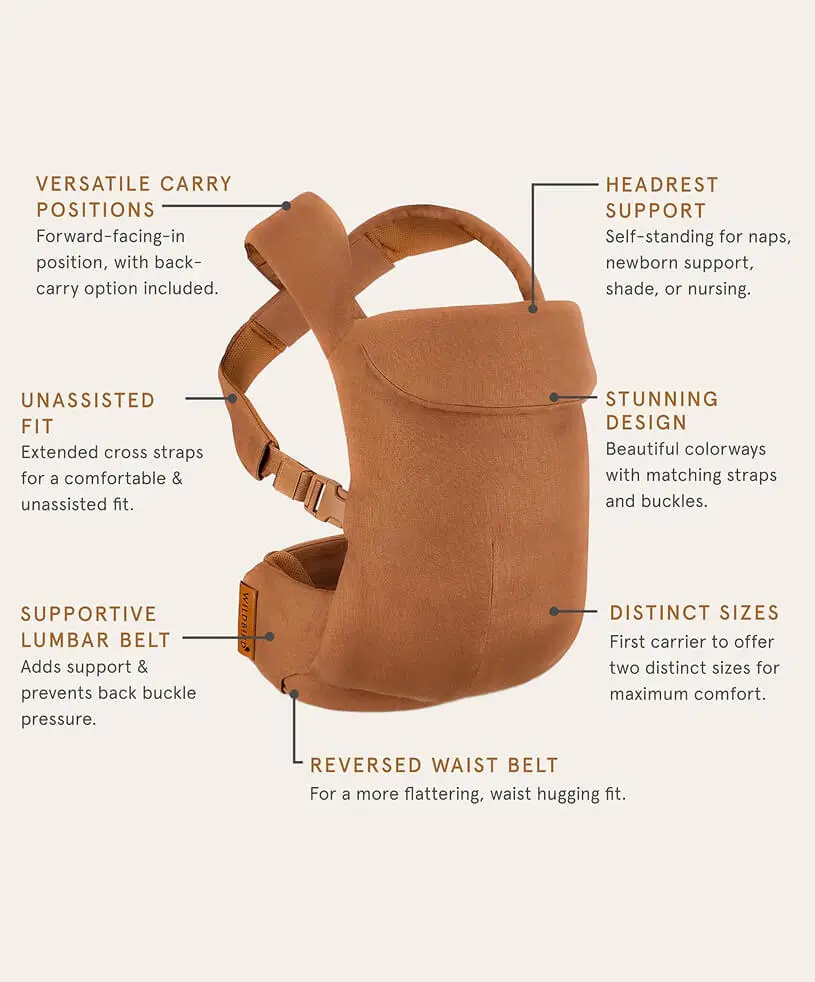
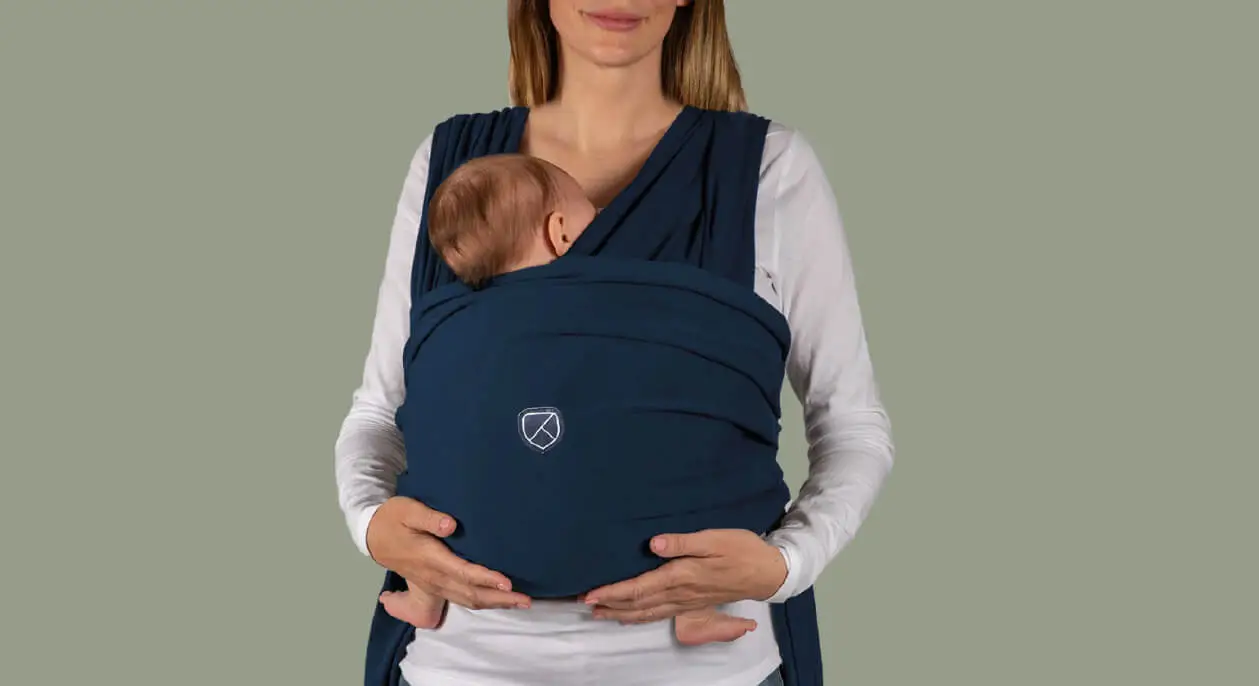

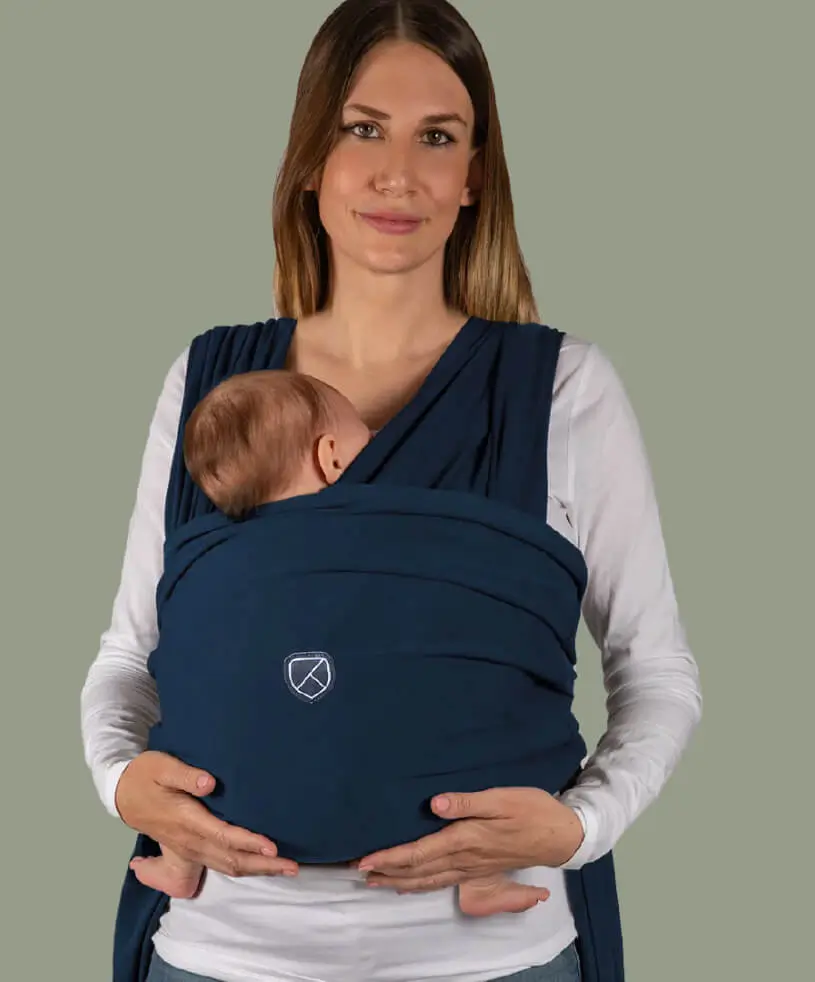

_%20Ergobaby%20Omni%20360.webp)
